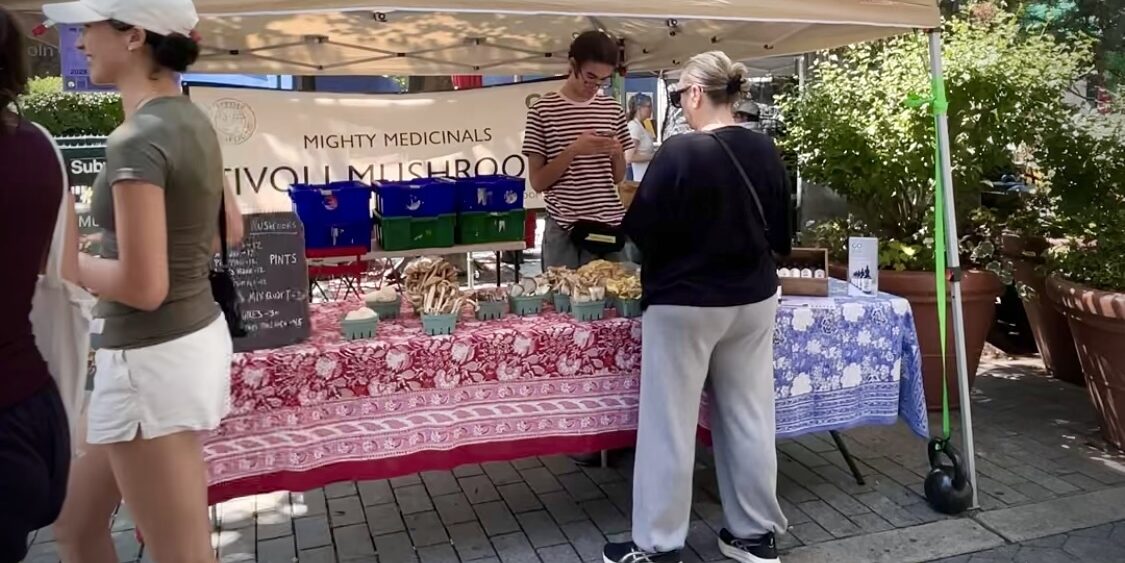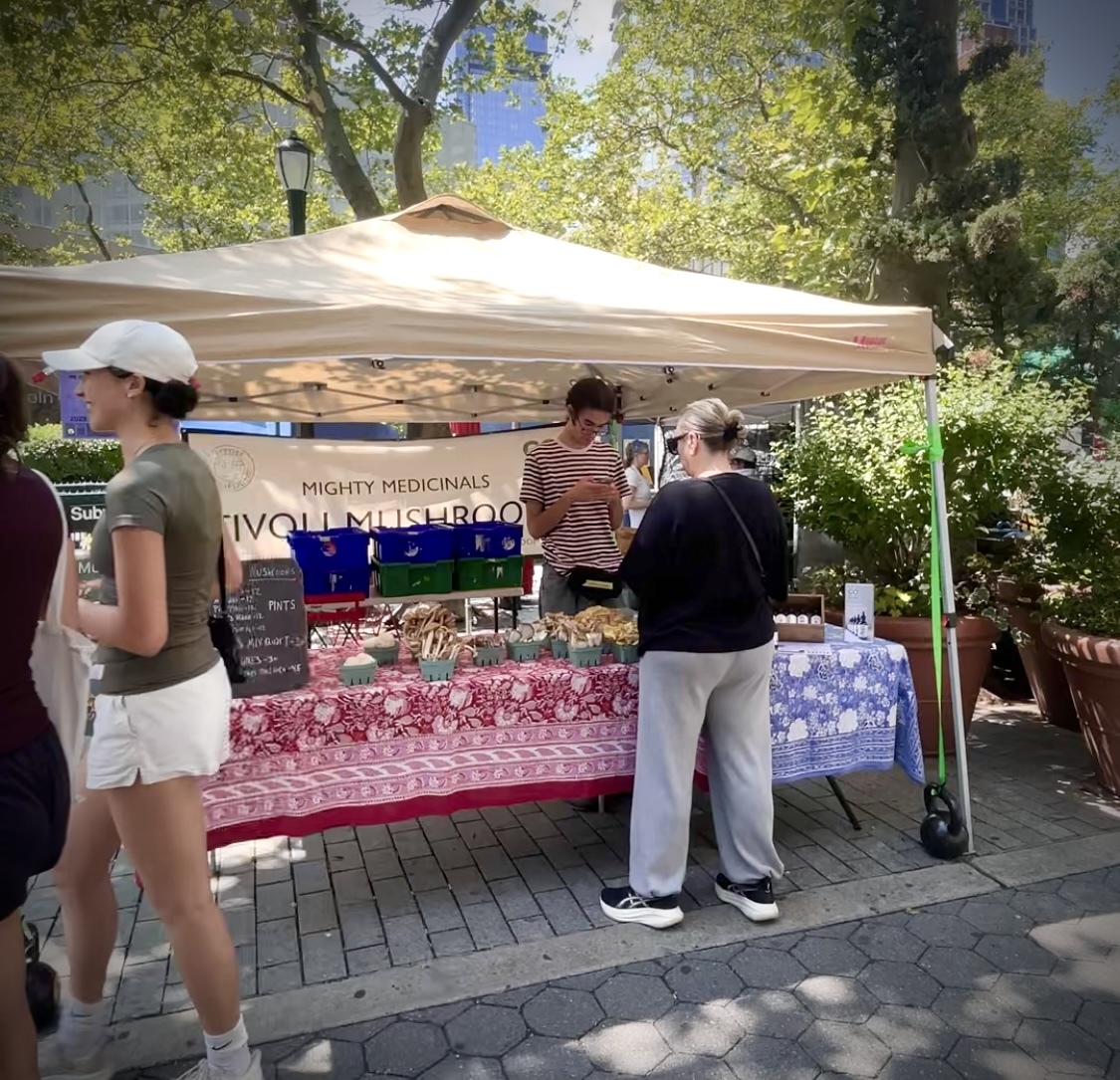 Photographs by Yvonne Vávra.
Photographs by Yvonne Vávra.
by Yvonne Vávra
For an embarrassingly long time, I thought mushrooms were just mushrooms, like how broccoli is just broccoli. In my mind, they came with one look: chubby stem, round cap, like something a child might draw. As you can tell, mushrooms and I weren’t exactly close.
Recently, though, I found myself on the edge of accidental mushroom enthusiasm. At the Tivoli Mushrooms stand at the Tucker Square Greenmarket on 66th and Broadway, no mushroom looked like a kid’s doodle, and the farmer charmed me into caring. Suddenly I was learning—and turning into someone who asks follow-up questions—about meaty, chewy, and silky textures; woodsy, nutty, and earthy flavors; shaggy mushrooms and mushrooms with skin like a dolphin. I think. I’ve never touched a dolphin, sadly.
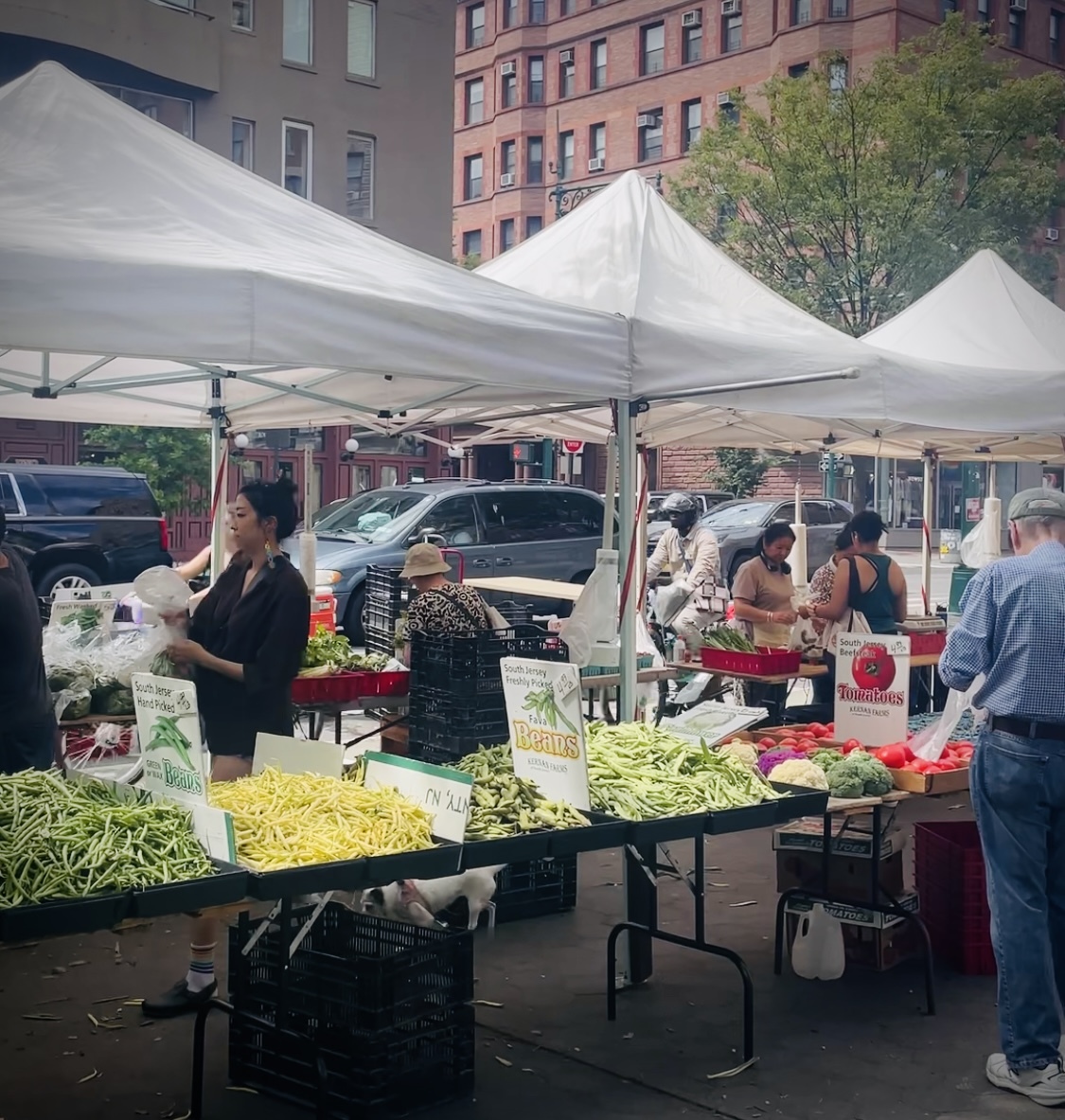 The Upper West Side has three official GrowNYC Greenmarkets, offering fruit and vegetables fresh from farms just outside the city. It’s a feast for your eyes and your hopeful little home cook heart. But that’s only half the fun. Across from Tivoli Mushrooms, I overheard two men getting way too fired up about the exact amount of olive oil needed to bring out the flavor of eggplant — which, one of them was adamant, must be roasted, not fried. I learned so much that day at Tucker Square.
The Upper West Side has three official GrowNYC Greenmarkets, offering fruit and vegetables fresh from farms just outside the city. It’s a feast for your eyes and your hopeful little home cook heart. But that’s only half the fun. Across from Tivoli Mushrooms, I overheard two men getting way too fired up about the exact amount of olive oil needed to bring out the flavor of eggplant — which, one of them was adamant, must be roasted, not fried. I learned so much that day at Tucker Square.
Deep down, we’re all farmers — if only by zip code lineage. Once upon a time, the entire Upper West Side was farmland. Wherever you put your feet today, imagine acres and acres of rolling fields: grassy hills dotted with farms and orchards, country estates, winding paths, and romantic rocks to sit on and ponder the bucolic dream that is your life.
In the 1660s, shortly after the English took the city from the Dutch and New Amsterdam became New York, the first English governor, Richard Nicolls, granted about 1,300 acres of what’s now Midtown West and the Upper West Side to five wealthy investors, who used the land primarily for farming. In 1745, a large swath of Upper West Side farmland ended up in the hands of Teunis Somarindyck and his new bride, Cornelia Dyckman. It was a wedding gift from her grandfather, Cornelius Dyckman Jr., and stretched from what’s now 73rd to 77th Streets, spanning the full width of today’s Upper West Side. The couple built their home near what is now Broadway and 75th Street, and, as the story goes, lived with royalty for a time, when French king Louis Philippe I stayed at the Somerindyck estate during his exile from France.
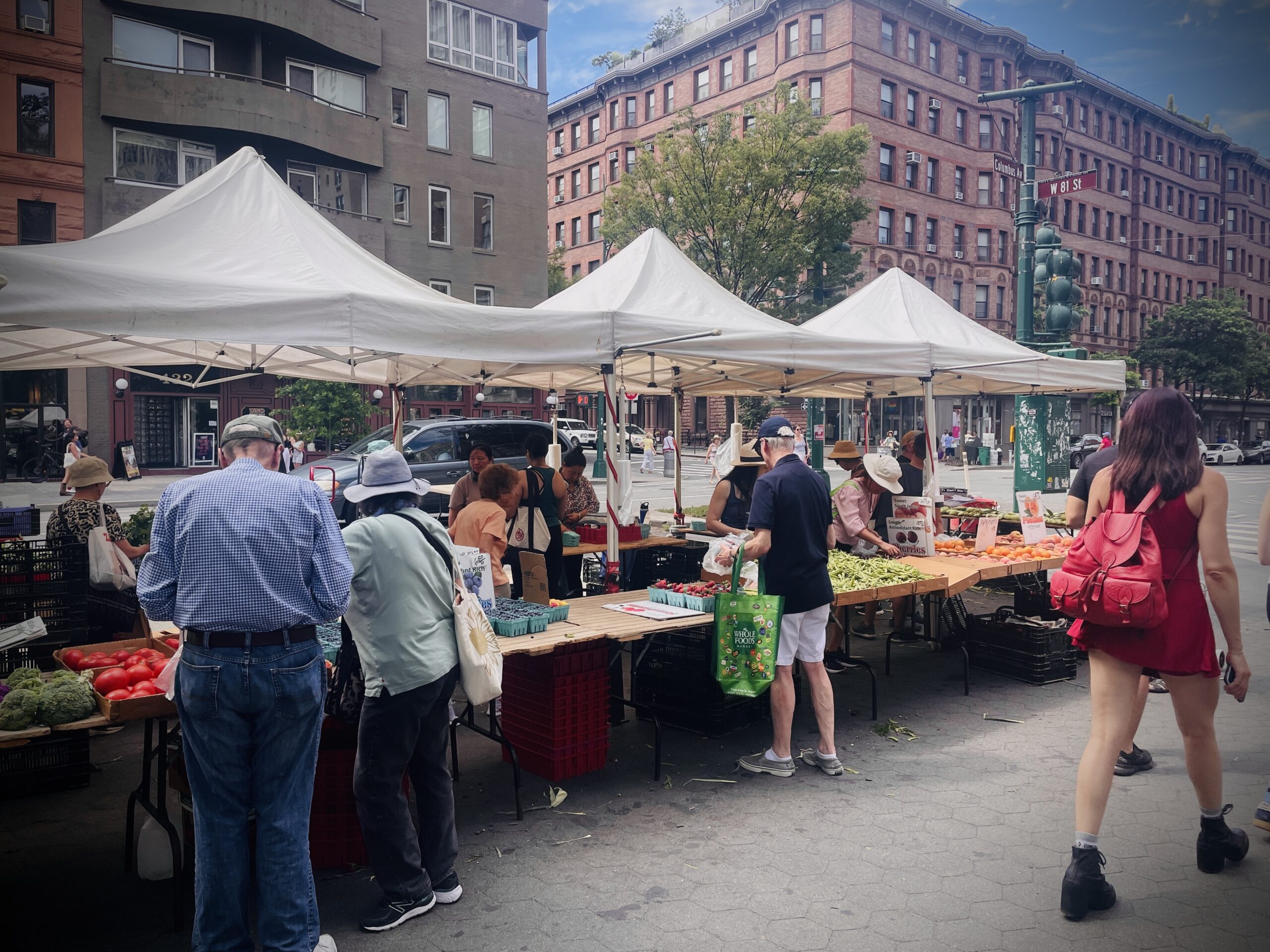 The New York Evening Post ran an ad in 1829 announcing the sale of the house and farm of Richard Somerindyck—Teunis’ son. The land was described as “highly cultivated, with a considerable number of fruit and forest trees, and a garden abounding with raspberries, strawberries, and etc.” The New York Historical also points to topographic maps showing that especially the more eastern area between 76th and 77th had ideal conditions for farming. And wouldn’t you know it — that’s exactly where today’s 79th Street Greenmarket sets up, stretching from 77th to 81st along Columbus. The strawberries are still abounding, though today they’re not Somerindyck’s but come from Kernan Farms in New Jersey.
The New York Evening Post ran an ad in 1829 announcing the sale of the house and farm of Richard Somerindyck—Teunis’ son. The land was described as “highly cultivated, with a considerable number of fruit and forest trees, and a garden abounding with raspberries, strawberries, and etc.” The New York Historical also points to topographic maps showing that especially the more eastern area between 76th and 77th had ideal conditions for farming. And wouldn’t you know it — that’s exactly where today’s 79th Street Greenmarket sets up, stretching from 77th to 81st along Columbus. The strawberries are still abounding, though today they’re not Somerindyck’s but come from Kernan Farms in New Jersey.
The Somarindyck farm was just one of many, and hardly any traces remain of them. But if you walk down Riverside Drive to the block between 91st and 92nd Streets, you can catch a flicker of those old farm days. There’s an alleyway between 190 and 194 Riverside Drive that, according to a 1989 report by the Landmarks Preservation Commission, is a “remnant of a path or lane that once led from the old Bloomingdale road (slightly off line with Broadway) to Twelfth Avenue” and that “separated the farms of Brouckholst Livingston to the south and R.L. Schieffelin to the north.”
There’s another piece of Upper West Side farm history still standing—but you’ll have to look up. This one thrived long after the heyday of agriculture, was tiny by any farming standard, and —oh yeah—was totally illegal: the rooftop farm on the Ansonia building. It had everything a farm needs, and then some. Some being a bear. A small one, granted.
Multimillionaire William Earle Dodge Stokes built the Ansonia between 1899 and 1904 with a vision of creating a residential hotel that could be at least partially self-sufficient. I’m not sure how the bear contributed to that idea, but there were also about 500 chickens, plus ducks, goats, a pig, and more. In 1907, however, someone tipped off the Health Department, and the bear, the chickens, and the dream all had to go.
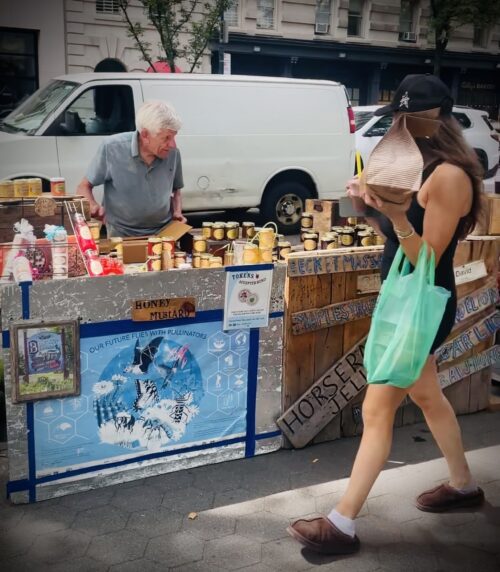 Gone are the days of bucolic vibes up here. But here we are, on the streets that paved over the pastures, picking out the best-looking strawberries, arguing over eggplants, and learning that a mushroom — Lion’s Mane, to be exact, currently chilling in my fridge awaiting its moment — can basically save your life with all its health benefits. That’s what the farmer said, anyway. Kind of wild to realize the land that once fed the city is still doing its thing. Just more tote bags now.
Gone are the days of bucolic vibes up here. But here we are, on the streets that paved over the pastures, picking out the best-looking strawberries, arguing over eggplants, and learning that a mushroom — Lion’s Mane, to be exact, currently chilling in my fridge awaiting its moment — can basically save your life with all its health benefits. That’s what the farmer said, anyway. Kind of wild to realize the land that once fed the city is still doing its thing. Just more tote bags now.
* * *
Yvonne Vávra is a magazine writer and author of the German book 111 Gründe New York zu lieben (111 Reasons to Love New York). Born a Berliner but an aspiring Upper West Sider since the 1990s (thanks, Nora Ephron), she came to New York in 2010 and seven years later made her Upper West Side dreams come true. She’s been obsessively walking the neighborhood ever since.
Subscribe to West Side Rag’s FREE email newsletter here. And you can Support the Rag here.
